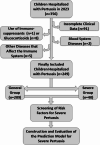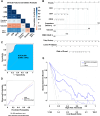Clinical and immunological predictors of severe pertussis in children: a nomogram-based prediction model
- PMID: 40731336
- PMCID: PMC12308945
- DOI: 10.1186/s12879-025-11366-8
Clinical and immunological predictors of severe pertussis in children: a nomogram-based prediction model
Abstract
Background: Despite widespread vaccination, pertussis remains a significant health concern, especially for infants and young children. Severe pertussis can lead to severe complications, but the specific risk factors, particularly immunological markers, are not fully understood.
Methods: This retrospective case analysis was conducted from January to December 2023 at the Department of Infection, Tianjin Second People's Hospital. Data were collected from 249 children with pertussis (209 common and 40 severe cases) who met the inclusion criteria. Clinical and immunological parameters were compared between severe and common pertussis groups. Lasso regression and multivariate logistic regression were used to identify independent risk factors, and a nomogram prediction model was constructed and validated.
Results: Key findings included demographic and clinical differences between severe and common pertussis, such as higher rates of pneumonia, longer hospital stays, and delayed vaccination in the severe group. Immunological differences showed that children with severe pertussis had altered levels of humoral and cellular immune markers. Risk factors for severe pertussis included premature birth, incomplete vaccination, high white blood cell count, and altered lymphocyte profiles. The nomogram prediction model showed excellent performance with a C-index of 0.899 and strong discriminatory ability (AUC = 0.899). Decision curve analysis demonstrated substantial clinical utility.
Conclusions: This study highlights the clinical and immunological markers that contribute to severe pertussis in children. The nomogram prediction model developed provides a reliable tool for early identification of high-risk children, improving clinical decision-making and potential outcomes for pertussis management.
Keywords: Immunological markers; Nomogram; Predictive model; Risk factors; Severe pertussis.
© 2025. The Author(s).
Conflict of interest statement
Declarations. Ethics approval and consent to participate: This study was approved by the Ethics Committee of Tianjin Second People’s Hospital (No.2019-46), and all methods were carried out in accordance with the relevant guidelines and regulations. Written informed consent was obtained from parents of each under aged participant. Consent for publication: Not applicable. Competing interests: The authors declare no competing interests. Clinical trial: Clinical trial number: not applicable.
Figures



Similar articles
-
Clinical characteristics of pertussis in infants and risk factors for respiratory support.Ann Med. 2025 Dec;57(1):2514943. doi: 10.1080/07853890.2025.2514943. Epub 2025 Jun 17. Ann Med. 2025. PMID: 40528283 Free PMC article.
-
Development and validation of a nomogram model for predicting the occurrence of necrotizing enterocolitis in premature infants with late-onset sepsis.Eur J Med Res. 2025 Jul 8;30(1):595. doi: 10.1186/s40001-025-02857-0. Eur J Med Res. 2025. PMID: 40629472 Free PMC article.
-
Does the Presence of Missing Data Affect the Performance of the SORG Machine-learning Algorithm for Patients With Spinal Metastasis? Development of an Internet Application Algorithm.Clin Orthop Relat Res. 2024 Jan 1;482(1):143-157. doi: 10.1097/CORR.0000000000002706. Epub 2023 Jun 12. Clin Orthop Relat Res. 2024. PMID: 37306629 Free PMC article.
-
Risk prediction of hepatotoxicity in paracetamol poisoning.Clin Toxicol (Phila). 2017 Sep;55(8):879-892. doi: 10.1080/15563650.2017.1317349. Epub 2017 Apr 27. Clin Toxicol (Phila). 2017. PMID: 28447858
-
Needle size for vaccination procedures in children and adolescents.Cochrane Database Syst Rev. 2015 Jun 18;(6):CD010720. doi: 10.1002/14651858.CD010720.pub2. Cochrane Database Syst Rev. 2015. Update in: Cochrane Database Syst Rev. 2018 Aug 09;8:CD010720. doi: 10.1002/14651858.CD010720.pub3. PMID: 26086647 Updated.
References
-
- Liu Y, Yu D, Wang K, Ye Q. Global resurgence of pertussis: A perspective from China. J Infect. 2024;89(5):106289. - PubMed
-
- Leontari K, Lianou A, Tsantes AG, Filippatos F, Iliodromiti Z, Boutsikou T, Paliatsou S, Chaldoupis AE, Ioannou P, Mpakosi A, et al. Pertussis in early infancy: diagnostic challenges, disease burden, and public health implications amidst the 2024 resurgence, with emphasis on maternal vaccination strategies. Vaccines (Basel). 2025;13(3):276. - PMC - PubMed
-
- Dyer O. Whooping cough: cases soar in US. BMJ. 2025;389:r704. - PubMed
MeSH terms
Substances
LinkOut - more resources
Full Text Sources
Medical
Miscellaneous

